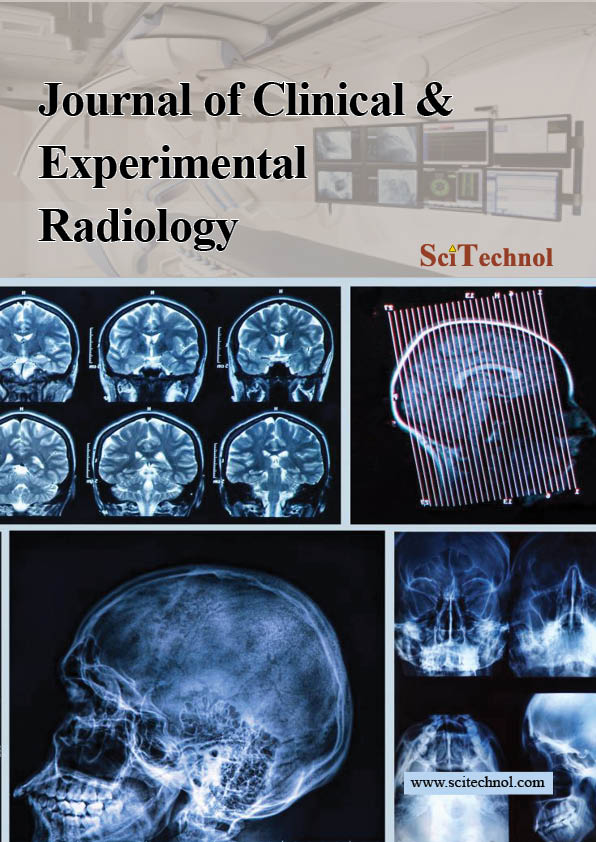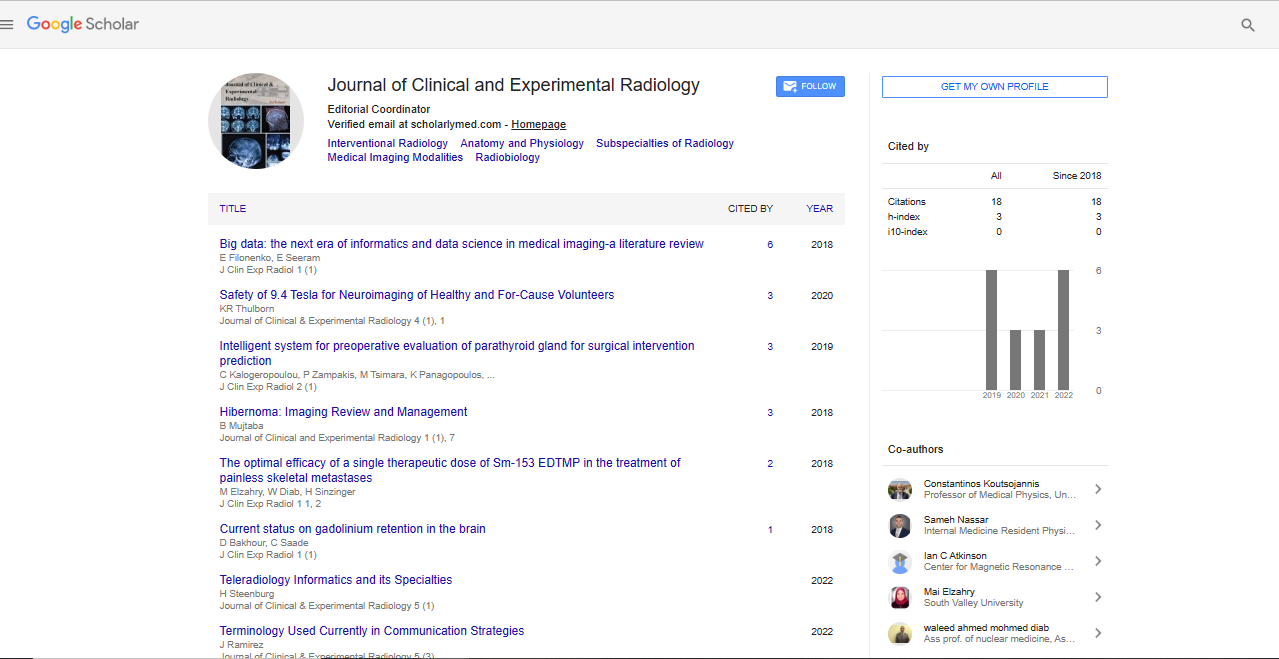About the Journal of Clinical & Experimental Radiology

Journal of Clinical & Experimental Radiology (JCER) is a peer reviewed Open Access journal that publishes latest advancements and innovations in the field of Clinical radiology and its impact on healthcare practices.
The Journal aims to provide a forum for widespread dispersal of research in diagnostic and therapeutic Radiology and Imaging Science covering all the research areas of Medical Imaging Studies that encompasses:
- Diagnostic Radiology
- Interventional Radiology
- Anatomy and Physiology
- Subspecialties of Radiology
- Medical Imaging Modalities
- Radiobiology
- Radiation Physics
- Radiotherapy
- Radiation Oncology
- Nuclear Medicine
- Molecular imaging
- Teleradiology
Submissions and review processing of the manuscripts is done through online and Editorial Manager System which enhances in maintaining the quality of the peer review process and delivers the easy access to the authors to track the status of the manuscript which includes the evaluation and publication details in an automated way. Subject experts will scrutinize the manuscripts under the supervision of the Editor-in-Chief. A minimum of two independent reviewers’ approval and decision of an editor is mandatory for the acceptance of the manuscript for publication. The journal adheres to a strict double blind peer review process.
Radiology
Radiology, also known as Roentgenology is a branch of science which deals with diagnosis and treatment of diseases with the aid of electromagnetic radiations, and some radioactive elements. The physician with specialises in this particular field is called a Radiologist.
Medical imaging
Medical imaging is also known as Diagnostic imaging, they utilise ionising radiations, except MRI and ultrasound. Sometimes even radioactive substances are used to produce visual imagesof the internal structures and any abnormalities like cancer related, heart related, etc. there are varied types of techniques being utilised to detect the disease.
Nuclear Medicine
Nuclear medicine imaging is a type of medical imaging, which utilises radiotracers that help in diagnosis of various diseases like cancer, heart problems, gastrointestinal problems, other abnormalities present in the body. This type of scans usually provides apt and precise results which are needed to make the diagnosis at an early stage.
Interventional radiology
Interventional radiology is a medical sub-specialty of radiology utilizing minimal invasive imaging techniques to treat or diagnose the illness in nearly every organ system. The aim behind interventional radiology is to diagnose and treat patients using the least invasive techniques currently available in order to minimize risk to the patient and improve health outcomes. These procedures have less risk, less pain and less recovery time in comparison to open surgery. For example- Angioplasty, Stenting, Atherectomy, Cryoplasty, Thrombolysis, and Embolization etc.
Radiation Therapy
Radiation therapy is a modern technique used commonly for destroying the cancerous cells present in the affected area. This therapy generally utilises the Electromagnetic radiations like (x-rays, gamma rays, protons etc.), targeted to the affected area. Sometimes to produce high energy radiation, accelerators are being used which increases the energy of the radiation and helps in destroying the target cells effectively. Most commonly used accelerators is cyclotrons, cobalt-60.
Radiation Oncology
Radiation oncology is that branch of radiology which deals with utilization of high energy radiations to treat the malignant or sometimes even benign form of carcinoma. Utilization of ionising radiations like (external beam radiations, internal radiations therapy).
Radiation Chemistry
Radiation chemistry is a subclass of nuclear chemistry which deals with the study of chemical consequences occur due to radiation on the biological matter; this is very different from radiochemistry as no radioactivity needs to be present in the material which is being chemically altered by the radiation.
Tele Radiology
Teleradiology deals with sharing the patient reports and images like their CT, MRI, and X-Ray with other radiologists or physicians. The patients care has improved and it has provided better and effective services without the physician actually being present at the location of patient.
CT & MR Imaging
CT and MRI are the techniques mainly used in diagnostic imaging. A CT Scan (or CAT scan) is best suited for viewing bone injuries, diagnosing lung and chest problems, and detecting cancers. An MRI is best suitable for imaging soft tissue in ligament and tendon injuries, spinal cord injuries, brain tumors, etc. CT scans are widely used in emergency cases because it can reveal internal injuries and bleeding quick enough to save someone’s life. Whereas an MRI, can take up to 30 minutes.
Radiation Biology
Radiobiology (also known as radiation biology) is a field of clinical and basic medical sciences that involves the study of the action of ionizing radiation on living things. Radiobiology, in general terms, is the science that estimates the effects of radiation in living bodies. In the field of radiation oncology, it is defined as the science that studies the interactions between ionizing radiation and living systems, and the consequences of these interactions.
Fast Editorial Execution and Review Process (FEE-Review Process):
Journal of Clinical & Experimental Radiology is participating in the Fast Editorial Execution and Review Process (FEE-Review Process) with an additional prepayment of $99 apart from the regular article processing fee. Fast Editorial Execution and Review Process is a special service for the article that enables it to get a faster response in the pre-review stage from the handling editor as well as a review from the reviewer. An author can get a faster response of pre-review maximum in 3 days since submission, and a review process by the reviewer maximum in 5 days, followed by revision/publication in 2 days. If the article gets notified for revision by the handling editor, then it will take another 5 days for external review by the previous reviewer or alternative reviewer.
Acceptance of manuscripts is driven entirely by handling editorial team considerations and independent peer-review, ensuring the highest standards are maintained no matter the route to regular peer-reviewed publication or a fast editorial review process. The handling editor and the article contributor are responsible for adhering to scientific standards. The article FEE-Review process of $99 will not be refunded even if the article is rejected or withdrawn for publication.
The corresponding author or institution/organization is responsible for making the manuscript FEE-Review Process payment. The additional FEE-Review Process payment covers the fast review processing and quick editorial decisions, and regular article publication covers the preparation in various formats for online publication, securing full-text inclusion in a number of permanent archives like HTML, XML, and PDF, and feeding to different indexing agencies.
 Spanish
Spanish  Chinese
Chinese  Russian
Russian  German
German  French
French  Japanese
Japanese  Portuguese
Portuguese  Hindi
Hindi 
